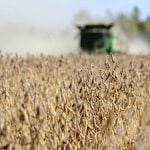Canadian and U.S. dry bean growers will likely reduce acres this spring, prompting some analysts to talk about potential for record prices.
Agriculture Canada forecasts a 10 percent decline in plantings and a nine percent reduction in supply due to lower production and carry-in stocks.
The situation is similar across the border. The U.S. Department of Agriculture’s prospective planting survey forecast dry bean acres will drop by eight percent compared to 2007.
“The decrease in planted acres can be mainly attributed to higher prices for competing crops and lack of soil moisture in some states,” said the USDA.
Read Also

Chinese offer complicates canola marketing
Recently the Chinese ambassador indicated that there would be a potential deal between Canada and China regarding the current tariff war.
In an earlier report, USDA said a five to nine percent drop in seeding would lead to a 10 percent drop in production assuming average yields.
“A smaller crop this fall would also make higher average dry bean prices (perhaps exceeding the 1988 record) during the 2008-09 marketing season a much safer bet,” said the USDA’s February vegetable and melons outlook.
Stan Skrypetz, market analyst with Agriculture Canada, said signs point toward a tighter North American supply.
“Basically, it means continuing good prices,” he said.
The U.S. aggregate grower price for all dry beans averaged 25 percent above a year earlier during the first five months of the 2007-08 marketing year. Pintos are up 18 percent, navies up 43 percent and blacks up 27 percent from a year earlier.
Prices have climbed steadily in Canada as well.
Todd Stewart, president of Manitoba Pulse Growers Association, said he was offered 41 cents per pound for an 800 lb. contract of navy beans. Over the past decade prices on a similar contract would have ranged from 24 to 30 cents per lb.
He said the U.S. and Canadian acreage estimates, which are in line with what his association was budgeting, could result in record prices.
“It is a possibility, but there are an awful lot of things that could happen to spoil that kind of fun,” Stewart said.
While the potential is there for good gross revenues, growers will have to manage expenses because beans are an input-intensive crop and input costs are rising.
Above average yields on either side of the border would quickly halt the run-up in prices. And if it’s a wet spring there could be more acres seeded than analysts anticipate. Manitoba bean dealers were getting lots of calls about seed availability when canola prices started to tumble a few weeks ago.
Stewart warned growers thinking about planting beans to quickly buy seed supplies.
“Some varieties might be hard to find,” he said.
There should be a strong market for many classes of beans in the coming year. The U.S. has been hungry for pinto, black and navy beans and importers are eager to capitalize on strong prices in that country.
“Imports are becoming a larger share of a few dry bean classes and foreign products may continue to grab an increasing share of the U.S. market,” said the USDA in its Feb. 20 outlook.
Dry bean imports from Canada rose 54 percent during the first four months of the 2007-08 marketing year and accounted for 40 percent of total U.S. imports during that period.
Imports to Mexico are also expected to increase slightly in 2008-09, despite an anticipated rise in production there.
The USDA Foreign Agricultural Service forecasts a nine percent increase in Mexican bean production to 1.2 million tonnes, up from 1.105 million in 2007-08, assuming an increase in harvested area and normal weather.















